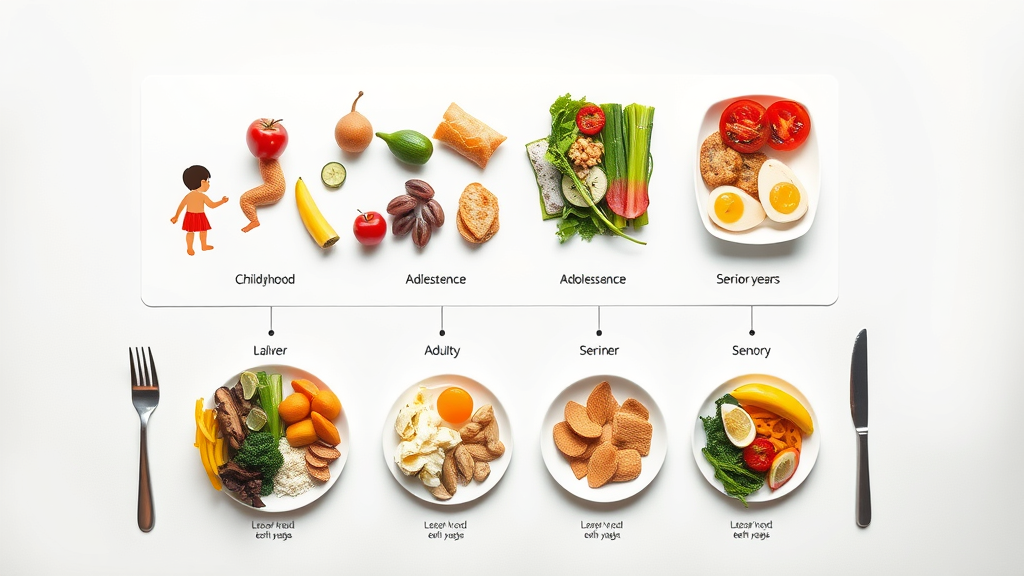Did you know? According to the World Health Organization, poor diet is linked to more than 20% of all deaths worldwide . This startling truth reveals that the food choices we make—across every age and stage of life—hold immense power over our lifelong health. Unlocking the secrets to nutrition for different ages isn’t just about following trends; it’s about embracing healthy eating practices that nurture your body from childhood through senior years. In this comprehensive guide, you'll discover practical advice, expert-backed meal plans, and tips customized to every life stage , so you can make every meal count toward a brighter, healthier future.
- How dietary needs change dramatically as we age
- Which food groups and nutrients matter most at key life stages
- Expert tips, meal plans, and strategies for lifelong healthy eating habits
Unlocking the Power of Nutrition for Different Ages: Why Your Dietary Needs Change Throughout Life

- Did you know? According to the World Health Organization, poor diet is linked to more than 20% of all deaths worldwide. Discover how tailoring nutrition for different ages can be your key to longevity and vibrant health.
The journey from childhood to senior years is marked by changing nutritional demands. At each life stage , our bodies require unique amounts of energy, protein, vitamins, and minerals to support growth, maintain muscle mass, and promote vibrant aging. For instance, children and teenagers face rapid growth spurts and need extra calcium and iron, while seniors benefit from foods rich in vitamin B12 and lower in sodium to help prevent chronic disease and maintain cognitive function. Adults, on the other hand, face daily stress and a higher risk of weight gain, making a balanced meal plan essential for optimal health. Understanding these shifting needs empowers us to make smarter food choices and set the foundation for a resilient, energetic life, no matter our age.
How Nutritional Needs Shift Across Life Stages: The Cornerstone of Healthy Eating
Our bodies constantly evolve, and so do their dietary requirements. The official dietary guidelines for Americans stress the importance of adjusting intake based on age, activity level, and health status. During childhood and adolescence, nutrient-dense meals foster healthy development. In adulthood, maintaining muscle mass and managing stress through balanced food groups becomes key. For older adults, overcoming decreased appetite, higher risk of nutrient deficiencies, and hydration challenges ensures vitality and independence. Recognizing these changes makes nutrition for different ages not just a guideline, but a necessity for a healthy, fulfilling life.
From Childhood to Senior Years: Life Stages and Core Food Group Requirements
Each life stage —from growth spurts in kids to muscle mass preservation in seniors—calls for different portions and combinations of the five main food groups : fruits, vegetables, grains, protein foods, and dairy or alternatives. Children experience heightened needs for calcium and vitamin D for bone growth; adolescents require iron for developing muscles and brains. By adulthood, it becomes essential to limit added sugar, saturated fat, and high in sodium foods while focusing on whole grains, lean proteins, and healthy fats. Seniors often need more fiber, vitamin B12, and hydration yet face challenges in appetite and digestion, necessitating thoughtful meal planning.
The federal government 's health care guidelines, reinforced by nutrition experts, highlight the evolving role of each food group in supporting energy, immunity, and disease prevention. Brighter, more colorful plates filled with a rich variety of vitamins and minerals propel well-being at every age—a simple visual that makes the science of healthy eating easy to grasp and even easier to put into action.
Dietary Guidelines: Adapting Your Meal Plan to Every Life Stage
Adapting your meal plan as you mature is the backbone of lifelong health. Dietary guidelines for Americans recommend prioritizing fruits, vegetables, whole grains, and lean proteins for all age groups, but the balance shifts with life’s milestones. Kids and teens benefit from more calcium-rich dairy products to fuel growth. Adults may need to watch portion sizes and prioritize heart-healthy fats while limiting added sugars and sodium. Seniors gain from fortified foods and supplements to fill nutritional gaps, and easy-to-chew textures to support changing dental health.
Following these recommendations isn’t just about avoiding disease—healthy eating improves energy, mood, and overall well-being at every life stage . Consulting a health professional or referencing a gov website like MyPlate can provide tailored nutrition information based on your specific age, health goals, and physical activity levels.

Understanding Food Groups and the Foundation of Nutrition for Different Ages
| Life Stage | Key Food Groups | Essential Nutrients | Unique Needs |
|---|---|---|---|
| Children (2–12 years) | Fruits, Vegetables, Dairy, Protein, Grains | Calcium, Iron, Vitamin D, Fiber | Supports growth spurt, bone development |
| Teenagers (13–18 years) | Fruits, Vegetables, Dairy, Protein, Whole Grains | Iron, Folate, B Vitamins, Calcium | Muscle mass, rapid development |
| Adults (19–64 years) | Vegetables, Fruits, Lean Protein, Whole Grains, Dairy/Alternatives | Protein, Fiber, Healthy Fats, Magnesium | Weight management, heart health |
| Seniors (65+ years) | Vegetables, Fruits, Protein, Dairy/Alternatives, Whole Grains | Vitamin B12, Calcium, Vitamin D, Fiber | Bone health, muscle mass preservation, hydration |
How Healthy Eating Patterns Evolve Over Time
Our bodies, tastes, and habits transform over the years, requiring us to adapt our healthy eating patterns to maintain optimal nutrition for different ages. In youth, habits formed around food groups and family meals often set the tone for lifelong health. As physical activity levels, metabolism, and dietary needs shift, so too should our approach—incorporating more fiber, lean protein, and foods low in added sugar and saturated fat. Transitioning from adolescent meals high in fruit juice and processed snacks to adult diets rich in vegetables and whole grains strengthens heart health and helps prevent chronic disease.
For older adults , taste changes and decreased appetite can pose challenges. Efforts to introduce fortified soy or dairy alternatives, along with vibrant, flavorful foods, can bridge nutrient gaps. Even after years of suboptimal eating, it’s never too late to improve your diet for greater energy and resilience. A proactive approach—fueled by the latest nutrition information from trusted gov or official websites—ensures every stage is met with targeted, delicious, and nutritious meals.
The Role of Fortified Soy, Dairy, and Alternatives in Meeting Dietary Guidelines
Meeting the evolving nutritional needs of all life stages is made easier with fortified soy drinks, dairy products, and plant-based alternatives. The dietary guidelines for Americans recommend fortified beverages for anyone who avoids traditional dairy, ensuring essential nutrients like calcium, vitamin D, and B12 are still accessible. Fortified soy, in particular, provides high-quality protein and is commonly recommended as a suitable alternative, supporting muscle mass and bone strength—especially in older adults .
Choosing fortified options helps bridge dietary gaps without the added saturated fat or cholesterol often found in some animal products. Whether you're a child needing robust growth, a teen requiring energy for a growth spurt, an adult managing heart health, or a senior aiming to preserve muscle and bone mass, integrating fortified dairy or plant-based options into your daily routine can support comprehensive, lifelong healthy eating.
Nutrition for Children and Teenagers: Building Blocks of a Healthy Foundation
Essential Food Groups for Growing Kids

Healthy growth during childhood and adolescence hinges on a variety of nutritious foods from every food group. Kids and teens need ample fruits and vegetables for vitamins and minerals, while dairy or fortified alternatives provide the calcium essential for bone development, especially during growth spurts. Whole grains deliver long-lasting energy, and lean proteins—from eggs, beans, fish, or meat—support muscle and tissue growth. Milk, yogurt, and fortified soy drinks are vital especially for children who avoid traditional dairy products. Ensuring colorful, appealing meals not only boosts nutrient intake but lays the groundwork for lifelong healthy eating habits.
Parents and caregivers play a pivotal role in developing children's taste for nutritious food. Encouraging participation in grocery shopping, involving children in meal preparation, and limiting access to highly processed, high in sodium or added sugar foods all contribute to healthier food choices. Remember, habits formed early often last into adulthood—make each meal an opportunity for discovery, joy, and nourishment.
Managing Added Sugar and Developing Lifelong Healthy Eating Habits
Added sugar lurks in many children’s favorite foods—cereals, fruit juice drinks, snacks, and sodas—and poses a health risk when consumed in excess. The dietary guidelines recommend limiting added sugars to less than 10% of total daily calories, helping to reduce the risk of tooth decay, unhealthy weight gain, and chronic conditions later in life. Instead, emphasize water, fresh fruits, and naturally sweetened options to develop better taste preferences and healthy eating habits from a young age.
Consistent modeling from adults—choosing whole foods over processed snacks and reading nutrition labels together—teaches children the value of informed food choices. Healthy eating patterns established during childhood and adolescence can help prevent chronic illnesses, obesity, and even some cancers in adulthood. By motivating children to try new foods and rewarding healthy choices, we help set a positive tone for a lifetime of wellness.
Nutrition for Adults: Optimizing Physical Activity and Dietary Guidelines
"The right balance of nutrients and physical activity can ward off chronic diseases long before they begin." – Registered Dietitian
Balancing Macros and Micros with Food Groups
Adults require a strategic balance of macronutrients —carbohydrates, protein, and healthy fats—to power daily activities, manage stress, and maintain lean muscle mass. Incorporating a variety of vegetables, fruits, whole grains, lean proteins, and dairy or fortified alternatives is central to the government’s dietary guidelines . Dietary fiber and antioxidants found in colorful plant foods support digestive health and lower the risk of heart disease, while lean proteins repair tissues and help keep metabolism robust.
Paying attention to micronutrient intake is just as vital; iron, zinc, magnesium, and vitamins such as B6 and B12 all contribute to energy, immunity, and optimal brain function. By spreading protein-rich foods throughout the day—including fortified soy or plant-based sources for vegetarians—adults can meet increased demands brought on by work, parenthood, and physical activity without exceeding energy intake or increasing saturated fat.
Practical Healthy Eating Tips for Busy Adults
Life’s pace often challenges even the best meal plans, but practical strategies make healthy eating achievable. Batch cooking healthy meals, stocking the pantry with low-sodium options, and prepping snack containers of fruit, veggie sticks, or nuts help curb added sugar cravings on busy days. Swapping out sweetened beverages for water or unsweetened tea, and reading food labels to avoid hidden sugars and sodium keeps dietary choices on track.
Don’t forget portion control and mindful eating—taking time to savor meals, eat slowly, and listen to hunger cues prevents overeating and supports healthy weight management. When eating out, choose grilled or steamed dishes, opt for whole grains instead of refined starches, and request sauces or dressings on the side. Remember, even small steps toward balanced meals accumulate for big wins in living healthier, longer, and happier lives.
Nutrition for Seniors: Meeting Dietary Challenges in Later Life Stages

Managing Added Sugars, Sodium, and Hydration as We Age
Aging brings unique nutrition challenges, including declining appetite, changes in taste and smell, and increased sensitivity to added sugars and sodium. High in sodium foods may contribute to high blood pressure, putting seniors at greater risk for heart disease and stroke. Similarly, high intake of added sugars—often from sweetened cereals or processed snacks—may elevate diabetes and weight gain risks. To counter this, reaching for fresh fruits, lightly seasoned vegetables, and whole grains low in sodium strengthens both health and flavor.
Hydration becomes critical in senior years. The sensation of thirst may diminish, but water is essential for cognitive function, digestion, and joint health. Seniors should aim for regular fluids throughout the day—water, herbal teas, or diluted fruit juice—with soups, stews, and juicy produce contributing to daily hydration needs. By prioritizing hydration and choosing foods naturally low in added sugars and sodium, older adults can support circulation, mobility, and overall well-being.
Adaptations in Dietary Guidelines for Seniors: Food Groups and Nutritional Adjustments
Seniors require more of certain nutrients—like calcium, vitamin D, fiber, and B12—while generally needing fewer calories. The dietary guidelines for Americans and official health care resources recommend focusing on nutrient-dense foods, including low-fat dairy products, fortified soy drinks, lean proteins, and plenty of colorful fruits and vegetables. Soft, easy-to-chew items such as yogurt, stewed chicken, or cooked grains often make eating easier and more comfortable.
Adapting meal texture, flavor, and timing is often necessary. Foods that are visually appealing and served in smaller, more frequent portions can boost appetite and satisfaction. Using aromatic herbs and spices instead of salt also helps prevent high sodium intake. Consulting a health professional ensures that older adults meet their unique nutrient needs while considering medications, chronic conditions, and mobility concerns.
Special Focus: The Impact of Fortified Soy and Plant-Based Alternatives on Nutrition for Different Ages
Meeting Protein and Calcium Needs Throughout Life Stages

With plant-based diets growing in popularity, fortified soy beverages and other alternatives are increasingly recognized as essential sources of protein and calcium—two nutrients vital across all life stages. For children and teens, fortified soy milk is an excellent alternative for those allergic to dairy, aiding in skeletal and muscle development. Adults can benefit from plant-based proteins to maintain lean body mass, particularly as metabolism starts to slow.
For older adults , these alternatives are especially beneficial: fortified soy contains complete protein and is generally lower in saturated fat than some animal foods, supporting muscle preservation and heart health. Additionally, vitamin D and B12 fortification in these beverages can help prevent the deficiencies often seen in seniors. By including fortified soy and a range of other plant-based options in your meal plan, you ensure optimal nutrient intake, sustainability, and delicious variety—an excellent strategy for nutrition for different ages .
List of Key Nutrition Recommendations for Each Life Stage
- Children: Prioritize fruits, vegetables, whole grains, and dairy or fortified alternatives. Limit added sugars and encourage water over sweetened drinks.
- Teenagers: Meet iron, calcium, and vitamin needs with lean meats, leafy greens, beans, and dairy. Support growth spurt with colorful plates and healthy snacks.
- Adults: Balance all food groups, watch saturated fat and added sugar intake, uphold daily physical activity, and maintain a fiber-rich diet.
- Seniors: Focus on protein, fiber, vitamin D, and calcium with easy-to-chew foods. Stay hydrated and opt for lower sodium options.
Expert-Backed Dietary Guidelines: Sample Meal Plans for Nutrition Across Different Ages
- Children: Breakfast: Oatmeal with berries and milk. Lunch: Turkey and veggie wrap, carrot sticks, and apple. Snack: Yogurt or fortified soy pudding. Dinner: Grilled salmon, brown rice, broccoli, fruit for dessert.
- Adults: Breakfast: Scrambled eggs with spinach, avocado toast. Lunch: Quinoa salad with lean chicken, chickpeas, and mixed veggies. Snack: Trail mix or cut fruit. Dinner: Baked tofu stir-fry, whole grain rice, and mixed greens.
- Seniors: Breakfast: Wheat porridge with chopped nuts and sliced banana. Lunch: Lentil soup, whole grain roll, mixed fruit cup. Snack: Hummus with soft veggie sticks. Dinner: Stewed chicken, mashed sweet potatoes, cooked carrots, and low-fat yogurt for dessert.
The Role of Physical Activity: Enhancing Nutrition Benefits at Every Life Stage
Pairing Physical Activity and Healthy Eating for Optimal Well-being

Nutrition and physical activity work hand-in-hand for lifelong wellness. Regular movement boosts muscle mass, assists in weight management, and deepens the positive impact of a healthy diet by lowering risk for chronic diseases at all life stages . For children, physical activity enhances bone strength and encourages healthy growth. Teens gain confidence and reduce stress through sports, while adults benefit from maintained muscle, heart health, and increased energy for daily tasks.
For seniors, mild but consistent activity like walking, swimming, or gardening maintains independence, flexibility, and reduces the risk of falls—especially when paired with nutrition rich in calcium, vitamin D, and protein. By adopting a lifestyle that values both smart food group choices and everyday movement, individuals can enjoy better mobility, cognition, and overall happiness at every life stage .
Frequently Asked Questions on Nutrition for Different Ages
- How do nutritional needs change as we age? Each life stage brings unique requirements: children need more nutrients for growth, adults balance energy and heart health, and seniors require extra attention to protein, calcium, and hydration.
- What are the best food groups for keeping energy levels high in seniors? Protein, whole grains, fruits, vegetables, and low-fat dairy or fortified soy drinks help maintain energy and preserve muscle mass in older adults.
- Is it ever too late to improve your diet? Never! Positive dietary changes can benefit health at any age, enhancing energy, immunity, and quality of life—even into senior years.
- How much added sugar is acceptable for kids vs. adults? Both should limit added sugars to less than 10% of daily calories; for children, even less is ideal, relying mostly on whole foods and naturally occurring sugars in fruits.
- Are plant-based diets suitable for all life stages? Yes, with proper planning to include key nutrients—complete proteins, calcium, vitamin B12—plant-based diets can support every age group.
People Also Ask
What are the most important nutrients for each age group?
Children need calcium, iron, and vitamin D for bone and immune system strength. Teenagers require extra protein and iron for muscle and hormonal development. Adults benefit from fiber, healthy fats, and antioxidants, while seniors should focus on vitamin B12, protein, calcium, and fluids to maintain muscle mass and prevent deficiencies.
How can I teach my child healthy eating habits early on?
Model healthy food choices, make mealtimes positive experiences, involve children in food shopping and preparation, and offer a variety of foods for tasting. Avoid using food as a reward or punishment and limit processed, high in sodium, and added sugar foods to establish lifelong healthy eating habits.
Why do dietary guidelines recommend different food group servings by age?
Different bodies have different nutritional needs as they grow, mature, or age, so serving sizes and food groups are tailored to support physical, cognitive, and metabolic changes at each life stage . This approach helps maximize health, growth, and disease prevention.
What role does physical activity play in healthy eating across the life stages?
Physical activity and balanced nutrition are mutually reinforcing—activity increases energy needs and supports muscle, while good nutrition fuels movement and supports recovery. Together, they ensure fitness, energy, and overall health from childhood through advanced age.
Case Studies: Real-Life Examples of Improving Nutrition for Different Ages
Take Maya, a 9-year-old who swapped sugary snacks for fruit and yogurt: her energy and school performance soared. Or John, a 45-year-old juggling a busy job, who replaced fast-food lunches with prepped salads, avoiding afternoon fatigue. And Judith, now 72, who overcame declining appetite by introducing fortified soy drinks and soft, vitamin-rich foods—her muscle strength and vitality have improved, allowing her to enjoy gardening and time with family. These real-life transformations underline the power of tailored nutrition at every life stage .
Watch our short, expert-led video guiding you through practical meal planning for children, adults, and seniors—see how balanced plates make a difference at every age.
Discover age-specific tips for establishing and maintaining healthy eating habits—from school lunches to senior-friendly snacks—in our engaging explainer video with nutrition professionals.
Wrap-Up: Start Your Healthy Eating Journey Tailored to Your Life Stage
"No matter your age, smart nutrition is the key to a better quality of life."
Take advantage of tailored nutrition for different ages by making small, steady improvements to your eating and activity habits today. Choose nutrient-dense foods, stay active, and adapt your meals as your needs and life stage evolve.
 Add Row
Add Row  Add
Add 




Write A Comment